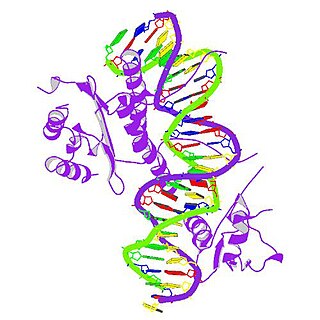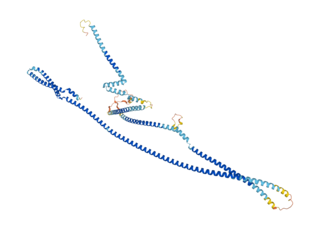CCAAT/enhancer-binding protein beta is a protein that in humans is encoded by the CEBPB gene. [5] [6]
CCAAT/enhancer-binding protein beta is a protein that in humans is encoded by the CEBPB gene. [5] [6]
The protein encoded by this intronless gene is a bZIP transcription factor that can bind as a homodimer to certain DNA regulatory regions. It can also form heterodimers with the related proteins CEBP-alpha, CEBP-delta, and CEBP-gamma. The encoded protein is important in the regulation of genes involved in immune and inflammatory responses and has been shown to bind to the IL-1 response element in the IL-6 gene, as well as to regulatory regions of several acute-phase and cytokine genes. In addition, the encoded protein can bind the promoter and upstream element and stimulate the expression of the collagen type I gene. [7]
CEBP-beta is critical for normal macrophage functioning, an important immune cell sub-type; mice unable to express CEBP-beta have macrophages that cannot differentiate (specialize) and thus are unable to perform all their biological functions - including macrophage-mediated muscle repair. [8] Observational work has shown that expression of CEBP-beta in blood leukocytes is positively associated with muscle strength in humans, [9] emphasizing the importance of the immune system, and particularly macrophages, in the maintenance of muscle function.
Function of CEBPB gene can be effectively examined by siRNA knockdown based on an independent validation. [10]
Upon further investigation, it was noted that CEBPB has close to 8,600 similar correlations with biological manipulations ranging from molecules to proteins or abstracted microRNAs. This protein is found in blood and is upregulated in diseases by acute myeloid leukemia, Glioma, and prostate cancer. This idea is predicated in an intracellular location and precisely localized to the nucleoplasm.
CEBPB is capable of increasing the expression of several target genes. Among them, some have specific role in the nervous system such as the preprotachykinin-1 gene, giving rise to substance P and neurokinin A [11] and the choline acetyltransferase responsible for the biosynthesis of the important neurotransmitter acetylcholine. [12] Other targets include genes coding for cytokines such as IL-6, [13] IL-4, [14] IL-5, [15] and TNF-alpha. [16] Genes coding for transporter proteins that confer multidrug resistance to the cells have also been found to be activated by CEBPB. Such genes include ABCC2 [17] and ABCB1. [18]
The CEBPB gene encodes a transcription factor. As previously mentioned, "It contains a leucine zipper (bZIP) domain and the encoded protein functions as a homodimer. It can also form heterodimers with enhancer-binding proteins such as alpha, delta, and gamma. The activity of this protein is important in regulating genes involving the immune and inflammatory responses, among other processes. The "AUG" start codons, resulting in multiple protein isoforms" [39]. [19] Anthough it was also mentioned that eachof these codon has a different biological function in the body.
This pathway allows for proliferation, inhibition, and even survival. This gene is a vital part of proliferation and segregation. It's important "as the transcription factor regulates the expression of genes that are involved in the immune and inflammatory response, it includes the gluconeogenic pathway and liver recovery. It has a probiotic effect on many cell types, like hepatocytes and adipocytes. However, it exerts differential "effects on T cells by inhibiting MYC expression and promoting differentiation of the T helper lineage." It binds to the regulatory regions of several phase and cytokine genes"[38]. [20]
CEBPB is a type of CEBP transcript. CEBPB [21] gene is noted in macrophages in SKCM and provides a favorable prognosis with metastatic cancer by being a biomarker for the patient's diagnosis stratification. Through integrated analysis of single-cell and bulk RNA-sequence datasets. Since CEBPB is a transcription factor in regulating gene expression, patients with metastatic melanoma may benefit long-term by blocking proteins such as CTLA-4 Other. Any other pathway of immune activation, such as targeting CEBPB. It is widely expressed in several different cancers.
CEBPB has been shown to interact with:
In molecular biology, a CCAAT box is a distinct pattern of nucleotides with GGCCAATCT consensus sequence that occur upstream by 60–100 bases to the initial transcription site. The CAAT box signals the binding site for the RNA transcription factor, and is typically accompanied by a conserved consensus sequence. It is an invariant DNA sequence at about minus 70 base pairs from the origin of transcription in many eukaryotic promoters. Genes that have this element seem to require it for the gene to be transcribed in sufficient quantities. It is frequently absent from genes that encode proteins used in virtually all cells. This box along with the GC box is known for binding general transcription factors. Both of these consensus sequences belong to the regulatory promoter. Full gene expression occurs when transcription activator proteins bind to each module within the regulatory promoter. Protein specific binding is required for the CCAAT box activation. These proteins are known as CCAAT box binding proteins/CCAAT box binding factors.

The glucocorticoid receptor also known as NR3C1 is the receptor to which cortisol and other glucocorticoids bind.

Transcription factor Sp1, also known as specificity protein 1* is a protein that in humans is encoded by the SP1 gene.

CCAAT-enhancer-binding proteins is a family of transcription factors composed of six members, named from C/EBPα to C/EBPζ. They promote the expression of certain genes through interaction with their promoters. Once bound to DNA, C/EBPs can recruit so-called co-activators that in turn can open up chromatin structure or recruit basal transcription factors.

An alveolar macrophage, pulmonary macrophage, is a type of macrophage, a professional phagocyte, found in the airways and at the level of the alveoli in the lungs, but separated from their walls.

The granulocyte-macrophage colony-stimulating factor receptor also known as CD116, is a receptor for granulocyte-macrophage colony-stimulating factor, which stimulates the production of white blood cells. In contrast to M-CSF and G-CSF which are lineage specific, GM-CSF and its receptor play a role in earlier stages of development. The receptor is primarily located on neutrophils, eosinophils and monocytes/macrophages, it is also on CD34+ progenitor cells (myeloblasts) and precursors for erythroid and megakaryocytic lineages, but only in the beginning of their development.

CAMP responsive element binding protein 1, also known as CREB-1, is a protein that in humans is encoded by the CREB1 gene. This protein binds the cAMP response element, a DNA nucleotide sequence present in many viral and cellular promoters. The binding of CREB1 stimulates transcription.

Myocyte-specific enhancer factor 2C also known as MADS box transcription enhancer factor 2, polypeptide C is a protein that in humans is encoded by the MEF2C gene. MEF2C is a transcription factor in the Mef2 family.

Tripartite motif-containing 28 (TRIM28), also known as transcriptional intermediary factor 1β (TIF1β) and KAP1, is a protein that in humans is encoded by the TRIM28 gene.

Nuclear transcription factor Y subunit beta is a protein that in humans is encoded by the NFYB gene.

CCAAT/enhancer-binding protein delta is a protein that in humans is encoded by the CEBPD gene.

CCAAT/enhancer-binding protein alpha is a protein encoded by the CEBPA gene in humans. CCAAT/enhancer-binding protein alpha is a transcription factor involved in the differentiation of certain blood cells. For details on the CCAAT structural motif in gene enhancers and on CCAAT/Enhancer Binding Proteins see the specific page.

Serum response factor, also known as SRF, is a transcription factor protein.

DNA damage-inducible transcript 3, also known as C/EBP homologous protein (CHOP), is a pro-apoptotic transcription factor that is encoded by the DDIT3 gene. It is a member of the CCAAT/enhancer-binding protein (C/EBP) family of DNA-binding transcription factors. The protein functions as a dominant-negative inhibitor by forming heterodimers with other C/EBP members, preventing their DNA binding activity. The protein is implicated in adipogenesis and erythropoiesis and has an important role in the cell's stress response.

Cux1 is a homeodomain protein that in humans is encoded by the CUX1 gene.

CCAAT/enhancer binding protein (C/EBP), epsilon, also known as CEBPE and CRP1, is a type of ccaat-enhancer-binding protein. CEBPE is its human gene and is pro-apoptotic.

Mediator of RNA polymerase II transcription subunit 23 is an enzyme that in humans is encoded by the MED23 gene.

Nuclear transcription factor Y subunit gamma is a protein that in humans is encoded by the NFYC gene.

CCAAT/enhancer-binding protein gamma (C/EBPγ) is a protein that in humans is encoded by the CEBPG gene. This gene has no introns.

Adipogenesis is the formation of adipocytes from stem cells. It involves 2 phases, determination, and terminal differentiation. Determination is mesenchymal stem cells committing to the adipocyte precursor cells, also known as preadipocytes which lose the potential to differentiate to other types of cells such as chondrocytes, myocytes, and osteoblasts. Terminal differentiation is that preadipocytes differentiate into mature adipocytes. Adipocytes can arise either from preadipocytes resident in adipose tissue, or from bone-marrow derived progenitor cells that migrate to adipose tissue.
This article incorporates text from the United States National Library of Medicine, which is in the public domain.